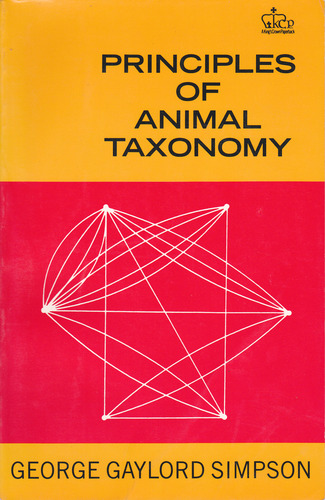Principles of animal taxonomy by George Gaylord Simpson


Principles of animal taxonomy George Gaylord Simpson ebook
Format: djvu
ISBN: 023109650X, 9780231096508
Publisher: Columbia University Press
Page: 131
The principles of naming new species of animals may seem like tedious legal work, but it can be fun—and sometimes you get to honor people as well with a new species named after them. English words do not need to be monophyletic. Simpson GG (1961) Principles of Animal Taxonomy. [that] are designed to enable zoologists to arrive at names for taxa that are correct under particular taxonomic circumstances. They then turn to taxonomy, as they study increasingly complex types of animals. The following is a brief summary on the principles and advancements of primary genetic markers involved in assessments of Animal Genetic Resources (AnGR). He studied botany and medicine and Of his higher groupings, only those for animals are still in use, and the groupings themselves have been significantly changed since their conception, as have the principles behind them. The same principle has been applied to understand the enormously diversified biological organisms, mainly animals and plants. French, German, Russian, and other languages do not have to accord with English ways of splitting up animals. The basic method of classifying the organisms has been the taxonomy. From microscopic investigation to the basics of veterinary medicine, Zoology covers principles of comparative animal anatomy, physiology, and genetics. This course begins with an overview of key concepts in zoology as students examine the characteristics of the animal cell and discuss heredity and issues of evolution, including natural selection. We shouldn't smuggle taxonomic principles into everyday language to make a political argument. Conversely, protein electrophoresis is a rapid, economic, and straightforward technique and provides a more detailed representation of polymorphisms than morphological or cytological markers; thus, it is still widely used in elucidating the origin and classification of species [10]. Comparison of exotic horn types The heroic age of biological taxonomy is long over, but anatomy as an explanatory principle is still able to take over with a special convincing force any wonderful being from the world of legends to our one. Linnaeus, Carolus (kärō'ləs lĭnā'əs), 1707-78, Swedish botanist and taxonomist, considered the founder of the binomial system of nomenclature and the originator of modern scientific classification of plants and animals. The principle behind the method is illustrated in Figure 1, which shows a single species splitting into two independently evolving populations that gradually diverge over time. Each recently discovered new animal or prodigious being became understandable and inserted in the common system for once as soon as its anatomy was described and, first of all, depicted. By method authors mean an arrangement of minerals, plants, and animals according to the principles of logical division. Taxonomy is international -- everywhere, we recognize that humans are hominoids.
Practical Algorithms for Programmers book download
Basic notions of condensed matter physics pdf free
Enterprise Integration Patterns: Designing, Building, and Deploying Messaging Solutions download
